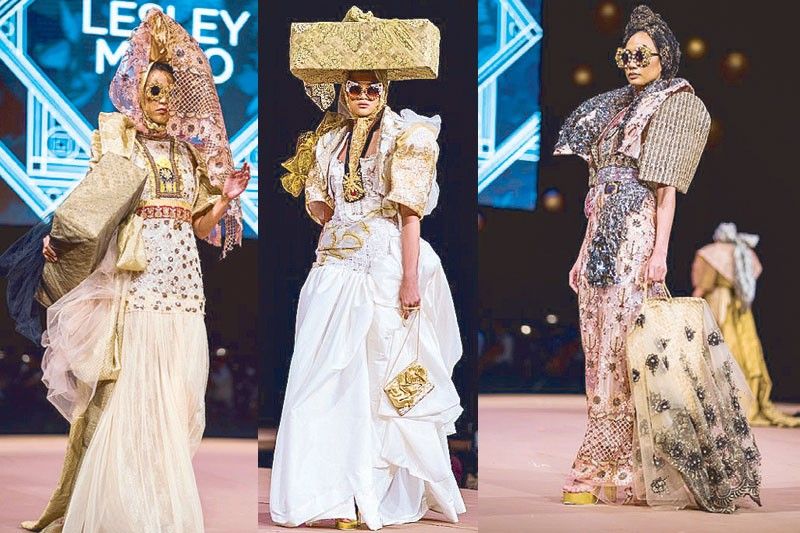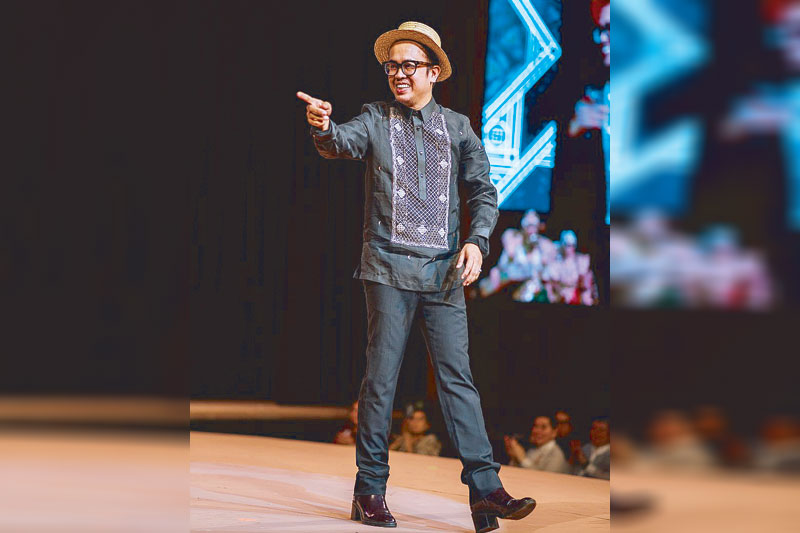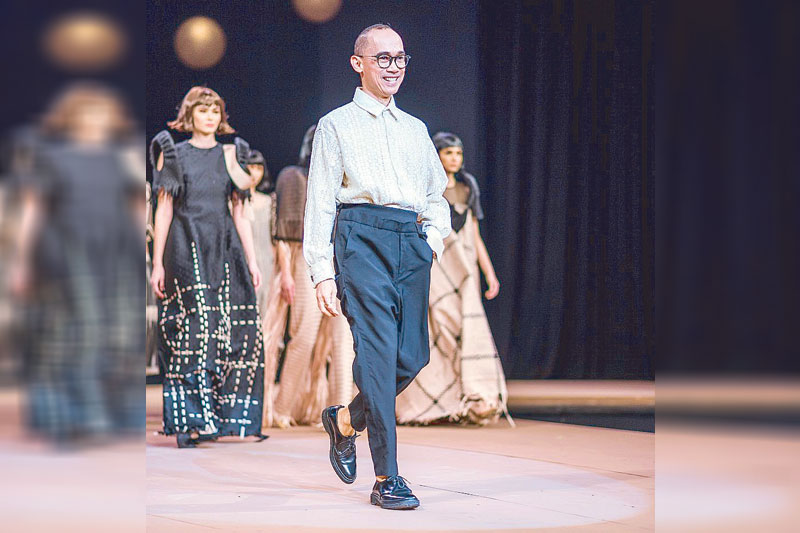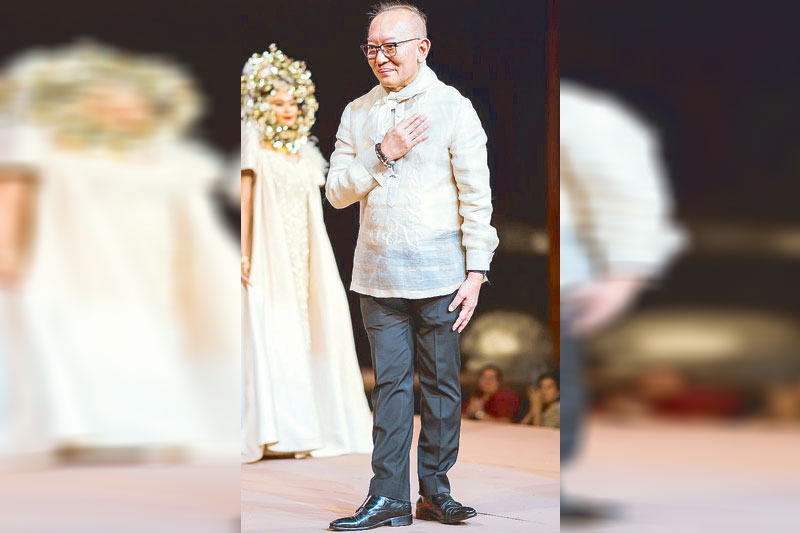The terno as cultural icon

Deafening silence throughout the Cultural Center of the Philippines’ Tanghanalang Nicanor Abelardo. An abrupt pause. Before this, the Philharmonic Orchestra was playing joyful tunes. Now the audience can’t even wonder aloud: What is happening?
We’re in the middle of Bench and CCP’s biannual Ternocon 2020 main program, and a Balintawak-clad elderly woman with disheveled long hair not unlike Noli Me Tangere’s Sisa takes over the stage. She is lugging a stuffed tampipi, as if she had just left her home in a frenzy and grabbed whatever for dear life. She opens her haul and unveils gizmos aplenty — but none as curious as the groovy sunglasses she tries on. A new perspective brings a smile to her face — and the audience's, too.
Over the last two years since the first Ternocon in 2018 and five years since the launch of Bench's Love Local advocacy campaign led by Bench founder and Ternocon chair Ben Chan, our cultural heritage is, now more than ever, integrated into our everyday life.
For generations, the Philippine national dress fell out of fashion for various reasons, encompassing negative connotations with the dress choice of a former dictator’s first lady to complaints no less impassioned: It’s a relic, it’s just not modern. But since Ternocon 2018, we're finally starting to see its renaissance. Filipinas now choose to wear the terno, and know they look best in it.
With this accomplishment, the Ternocon 2020 collections by this year’s mentors go beyond making the terno wearable, instead using fashion as a medium, looking deeper into our historical and cultural past.

Lesley Mobo: An intersection of personal and historical timelines
The music swells. Lesley Mobo’s maximalist glam lolang albularyos come sashaying through.
“It’s a narrative or metaphor that Filipinos are always running away from their homes,” the designer explains to YStyle. “It started from a picture in the book, Fashionable Filipinas: a 1910 photo of women vendors standing under the sun at the Cebu port, carrying large stacks of pillows on their heads. They were basically running away from the Japanese war, but sabi ko to Gino (Gonzales, Ternocon artistic director and co-author of the book) that I’d like to use it as a metaphor. Filipinos are always leaving, running away from the Spanish, from the Japanese, from the Americans, and now the Filipinos are leaving the country to go somewhere for a better life.”
Now, to the details: hand-embroidered at Fitzrovia, London by Hand & Lock, famed embroiderers to the British Royalty since 1767 and couturiers such as Christian Dior, Norman Hartnell and Hardy Amies on gowns for the Queen, The Queen Mother and the late Princess Diana. A coming together of two parts of Mobo’s life, Aklan-born and now London-based.
His collection is comprised of oversized layers of rich materials and textures: draped saya is embellished with solihiya weave and flattened antique gold metal that is made into a lace trim, overlaid on a dirty milk lace base. Emerald woven silk is decorated with orasyon detailing, hand-embroidered gold coil, the Catholic scapular with a silk bow, side-by-side with a sequined anting-anting, panakot sa aswang red pouch with heart-shaped paillettes, gold lace and tapis pinned with larger gold emperdibles, gold panuelo with the Philippine sun patterns repeated throughout and layered with lace embroidered camisa with the terno’s butterfly sleeves. The fabrics are draped as if they are billowing in the wind, like in the photograph that inspired it all.
Ivarluski Aseron: Weaving the terno with the banig
For his collection, Ivarluski Aseron gives the banig the attention it deserves. He opens it with a showcase of all its regional forms, coming alive onstage with various dances from all over the Philippines that make use of the hand-woven mat that’s an essential in Filipino households.
“In years gone by, Filipinos slept on banigs underneath a kulambo. Banigs were essential to daily living then. The weavers kept the banigs from being boring by producing intricate patterns and using different weaving techniques. It became my inspiration, thus producing different patterns of weaves,” he explains, calling the collection “Himlay.”
The rustic look and ubiquity of the banig belies the tedious process that goes to the creation of each piece, from sourcing, treating and drying the materials before they are meticulously woven according to each region’s diverse style, using a technique passed down through generations.
Aseron’s collection highlights this process in its various stages of creation, from the loose, flowing fringes on a floor-length gown to a trapeze-cut gown, rendered in luxurious silk gazar and a cosmopolitan color-scheme of beige and black, where he exposes his technique with the terno’s inside pleating, leaving the edges undone. It’s an artistic statement, rewriting the cultural connotations of the terno and banig.
Philip Rodriguez: The terno and the Catholic imagination
Cebu’s foremost fashion designer Philip Rodriguez’s collection is an act of religious devotion. Recognizing the visual effect of fashion on the Catholic faith, he dresses the modern Filipina in the same Baroque regalia worn by the Santo Nino, the Infant Jesus of Cebu, who recently drew thousands of devotees from all around the country to the annual Sinulog.
Going full-on traditional in his execution, the finale piece is an ecru terno with a cape inspired by the one the Santo Niño wears. It is preceded by formal separates: high-necked piña callado reminiscent of nun’s habits or Catholic schoolgirls’ uniforms with ball skirts. Most traditional of them all is a formal terno made of black Chantilly lace, decorated with a solitary rose corsage, still worn to this day by the most pious of churchgoers. Yet there’s something modern about it: this is the Filipina, typically depicted in history as oppressed, now taking back the power of the imperial conquistadors, and reveling in its grandeur.
* * *
For a closer look, the limited-edition book Ternocon 2020: Reimagining the Philippine Terno is available at @artbooksph.

















